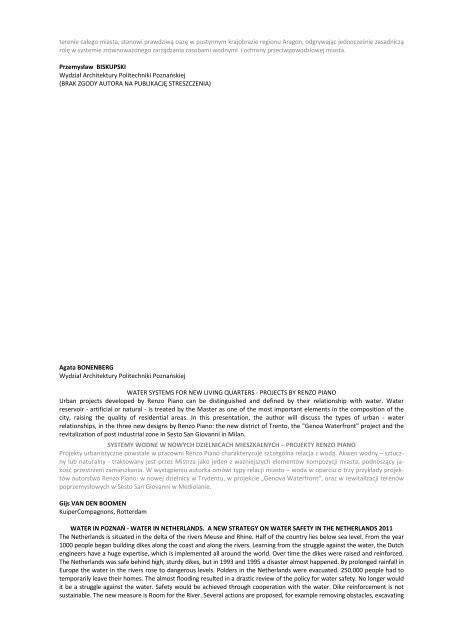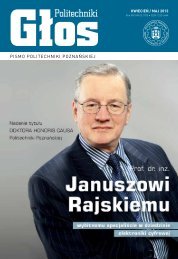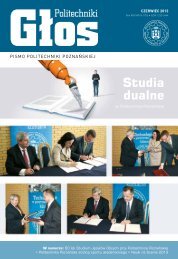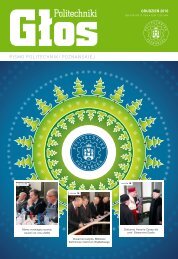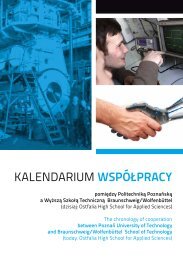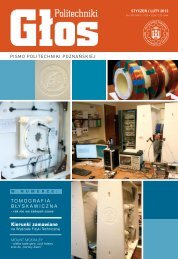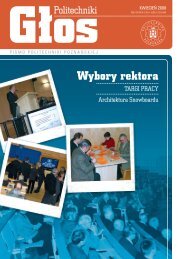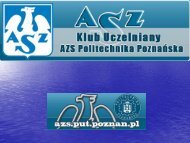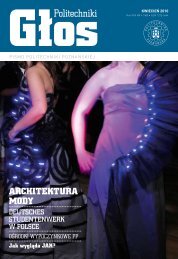2WATER PROCEEDINGS.pdf - AktualnoÅci Politechniki PoznaÅskiej
2WATER PROCEEDINGS.pdf - AktualnoÅci Politechniki PoznaÅskiej
2WATER PROCEEDINGS.pdf - AktualnoÅci Politechniki PoznaÅskiej
You also want an ePaper? Increase the reach of your titles
YUMPU automatically turns print PDFs into web optimized ePapers that Google loves.
terenie całego miasta, stanowi prawdziwą oazę w pustynnym krajobrazie regionu Aragon, odgrywając jednocześnie zasadniczą<br />
rolę w systemie zrównoważonego zarządzania zasobami wodnymi i ochrony przeciwpowodziowej miasta.<br />
Przemysław BISKUPSKI<br />
Wydział Architektury <strong>Politechniki</strong> Poznańskiej<br />
(BRAK ZGODY AUTORA NA PUBLIKACJĘ STRESZCZENIA)<br />
LANDSCAPES OF POZNAŃ<br />
One of the forms of introducing in extensive context of town space and documenting changes are pictures made in many<br />
different art techniques. In consideration of particular view of space town these pictures we call town landscapes. They<br />
show not only existing view of town; show the character of this town too. In the last two hundred years central space of<br />
Poznań changed in significantly way changing repeatedly the character and view of space. The reasons of this situation are<br />
Prussian political activity in XIX centuries and communist transform of central space of Poznań in XX centuries. These<br />
changing gave quite different view of space. The most important is, that we cannot see how exactly space of Poznań look<br />
like two or three hundred years before because we have the shortage of iconography and information about that space.<br />
Most pictures from XVIII and the beginning XIX centuries showing the town space only in very deformed or limited way.<br />
There are only few pictures were we see all town. This kind of showing town space is connected with obligatory in that<br />
times art convention, art level of painters, and kind of see the space. First photography pictures of Poznań space was made<br />
in the middle of the XIX century. But in that times space of Poznań has already changed in the most way, and on these<br />
pictures we can see only space in a new face. This situation brings many different opinions about space shape of Poznań in<br />
XVIII centuries and earlier, and his beauty, and makes often a lot of hot discussions about it. By means of maps and pictures<br />
from XVIII and XIX centuries in my work I tried to reproduce space town, its buildings and surrounding nature. I show this<br />
earlier in my article “Broken identity of Poznań space structure.” Here by the method of flat projective on photo picture of<br />
present space I show how this space looked like two or three hundred years before. I choose five characteristically places<br />
where urban space is connected with nature. In this moment I tried to approach the character of historical Poznań, town<br />
put down in wonderful nature environment where always main element was water. By means of compare earlier and<br />
present spaces I try to show changing in space town in the last two hundred years where destroyed historical town space its<br />
composition structure and nature environment.<br />
PEJZAŻE POZNANIA<br />
Jedną z form przedstawiania w szerszym kontekście istniejącej przestrzeni miejskiej jak i dokumentowania zmian w niej<br />
zachodzących są obrazy (wykonane w różnych technikach), które nazywa się pejzażami miasta. Rejestrują one nie tylko<br />
istniejący w danym momencie wizerunek struktury miejskiej, ale przede wszystkim starają się oddać jej charakter.<br />
W ostatnich dwustu latach centralna przestrzeń Poznania została w sposób znaczący przekształcona zmieniając wielokrotnie<br />
jej charakter jak i wizerunek. Szczupłość ikonografii jak i informacji o przestrzeni szczególnie z okresu przedrozbiorowego<br />
pozostawia wiele pytań, co do jego wyglądu. Obecnie jest to też temat wielu dyskusji. Do takiego stanu rzeczy przyczyniły<br />
się bardzo różne czynniki powodując zniekształcony, oraz niepełny obraz przeszłości. Niniejszy artykuł jest próbą przybliżenia<br />
wizerunku Poznania z tamtych czasów, jako miasta krajobrazowego przepięknie wpisanego w przyrodniczy kontekst<br />
otoczenia, w życiu, którego dominującą rolę zawsze odgrywała woda. Poprzez analizę porównawczą starałem się również<br />
ukazać zmiany dokonane w tkance miejskiej w przeciągu ostatnich dwustu lat.<br />
Agata BONENBERG<br />
Wydział Architektury <strong>Politechniki</strong> Poznańskiej<br />
WATER SYSTEMS FOR NEW LIVING QUARTERS - PROJECTS BY RENZO PIANO<br />
Urban projects developed by Renzo Piano can be distinguished and defined by their relationship with water. Water<br />
reservoir - artificial or natural - is treated by the Master as one of the most important elements in the composition of the<br />
city, raising the quality of residential areas. In this presentation, the author will discuss the types of urban - water<br />
relationships, in the three new designs by Renzo Piano: the new district of Trento, the "Genoa Waterfront" project and the<br />
revitalization of post industrial zone in Sesto San Giovanni in Milan.<br />
SYSTEMY WODNE W NOWYCH DZIELNICACH MIESZKALNYCH – PROJEKTY RENZO PIANO<br />
Projekty urbanistyczne powstałe w pracowni Renzo Piano charakteryzuje szczególna relacja z wodą. Akwen wodny – sztuczny<br />
lub naturalny - traktowany jest przez Mistrza jako jeden z ważniejszych elementów kompozycji miasta, podnoszący jakość<br />
przestrzeni zamieszkania. W wystąpieniu autorka omówi typy relacji miasto – woda w oparciu o trzy przykłady projektów<br />
autorstwa Renzo Piano: w nowej dzielnicy w Trydentu, w projekcie „Genova Waterfront”, oraz w rewitalizacji terenów<br />
poprzemysłowych w Sesto San Giovanni w Mediolanie.<br />
Gijs VAN DEN BOOMEN<br />
KuiperCompagnons, Rotterdam<br />
WATER IN POZNAŃ - WATER IN NETHERLANDS. A NEW STRATEGY ON WATER SAFETY IN THE NETHERLANDS 2011<br />
The Netherlands is situated in the delta of the rivers Meuse and Rhine. Half of the country lies below sea level. From the year<br />
1000 people began building dikes along the coast and along the rivers. Learning from the struggle against the water, the Dutch<br />
engineers have a huge expertise, which is implemented all around the world. Over time the dikes were raised and reinforced.<br />
The Netherlands was safe behind high, sturdy dikes, but in 1993 and 1995 a disaster almost happened. By prolonged rainfall in<br />
Europe the water in the rivers rose to dangerous levels. Polders in the Netherlands were evacuated. 250,000 people had to<br />
temporarily leave their homes. The almost flooding resulted in a drastic review of the policy for water safety. No longer would<br />
it be a struggle against the water. Safety would be achieved through cooperation with the water. Dike reinforcement is not<br />
sustainable. The new measure is Room for the River. Several actions are proposed, for example removing obstacles, excavating


